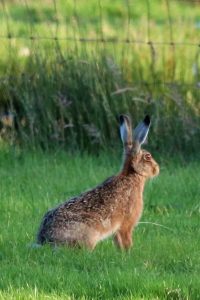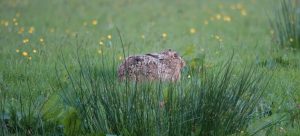Why March?
March is the prime month for hare-watching because it marks the peak of their breeding season. Unlike rabbits, which live in burrows, brown hares prefer open farmland and grassland, making them easier to spot—if you know where to look. Their behaviour at this time of year is particularly striking, as males (bucks) and females (does) engage in energetic chases and dramatic ‘boxing’ matches.

The ‘Mad March’ Boxing Hares
The sight of two hares standing on their hind legs, swiping at each other with their front paws, is an iconic image of British wildlife. This ‘boxing’ is not two males fighting, as is often assumed, but rather a female fending off an overly persistent male. The display is a test of stamina and persistence, ensuring only the strongest and most determined bucks get to mate.
Where to Find Brown Hares
Brown hares are found across the UK, particularly in open farmland, grasslands, and heathlands. In addition to the Forest of Bowland, some of the best locations to spot them include:
- The chalk downs of southern England
- The Yorkshire Dales and Peak District
- The Norfolk and Suffolk Brecks
- The Scottish Borders and lowlands
The best time to observe them is early in the morning or late in the afternoon when they are most active. A pair of binoculars and a quiet approach will increase your chances of a sighting.
Conservation Concerns
 Despite their presence in the countryside, brown hare numbers have declined significantly due to habitat loss, modern farming practices, and predation. They are now considered a priority species for conservation in the UK. Supporting wildlife-friendly farming and leaving undisturbed areas in rural landscapes can help ensure their survival.
Despite their presence in the countryside, brown hare numbers have declined significantly due to habitat loss, modern farming practices, and predation. They are now considered a priority species for conservation in the UK. Supporting wildlife-friendly farming and leaving undisturbed areas in rural landscapes can help ensure their survival.
Get Out and Look for Hares This March
There’s something truly magical about spotting a hare sprinting across an open field or witnessing a dramatic boxing match in the early morning light. So, wrap up warm, grab your binoculars, and venture into the countryside this March—you might just witness one of nature’s most captivating seasonal spectacles.
Have you seen brown hares in the wild? Share your sightings and experiences in the comments below!